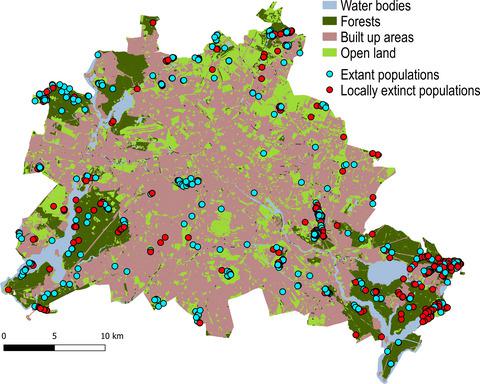当前位置:
X-MOL 学术
›
J. Appl. Ecol.
›
论文详情
Our official English website, www.x-mol.net, welcomes your
feedback! (Note: you will need to create a separate account there.)
Plant traits, biotopes and urbanization dynamics explain the survival of endangered urban plant populations
Journal of Applied Ecology ( IF 5.0 ) Pub Date : 2020-06-02 , DOI: 10.1111/1365-2664.13661 Greg Planchuelo 1 , Ingo Kowarik 1, 2 , Moritz von der Lippe 1, 2
中文翻译:

植物性状,生物群落和城市化动态解释了濒临灭绝的城市植物种群的生存
更新日期:2020-06-02
Journal of Applied Ecology ( IF 5.0 ) Pub Date : 2020-06-02 , DOI: 10.1111/1365-2664.13661 Greg Planchuelo 1 , Ingo Kowarik 1, 2 , Moritz von der Lippe 1, 2
Affiliation

|
- With accelerating urbanization, the urban contribution to biodiversity conservation becomes increasingly important. Previous research shows that cities can host many endangered plant species. However, fundamental questions for urban nature conservation remain open: to what extent and where can endangered plant species persist in the long term and which mechanisms underlie population survival?
- We evaluate the survival of 858 precisely monitored populations of 179 endangered plant species in Berlin, Germany, by assessing population survival throughout different urban ecosystems over a period of 7.6 years on average. By linking population survival to various landscape variables and plant traits, we unravel the underlying drivers.
- More than one–third of populations went extinct during the observation period. Population survival was inversely correlated to the increase in impervious surfaces in the vicinity following the first 11 years after the fall of the Berlin wall. Additionally, populations in semi‐natural habitats like forests and bogs were surprisingly more prone to local extinction than populations in anthropogenic habitats. Survival was highest for competitive species with a preference for drier soils (Ellenberg indicator for soil humidity).
- Synthesis and applications. Considerable levels of local population extinction demonstrate that the presence of endangered plants cannot be directly linked with their long‐term survival in cities. However, the survival of remaining populations indicates opportunities for urban biodiversity conservation both within and outside conservation areas. The elucidated links between population survival, urbanization dynamics, biotope class and species traits support urban conservation strategies that reduce the proportion of impervious surface, prioritize conservation management in forests and grasslands and explore the opportunities of green spaces and built‐up areas.
中文翻译:

植物性状,生物群落和城市化动态解释了濒临灭绝的城市植物种群的生存
- 随着城市化进程的加快,城市对生物多样性保护的贡献日益重要。先前的研究表明,城市可以容纳许多濒危植物。但是,城市自然保护的基本问题仍然悬而未决:受威胁的植物物种可长期持续到何种程度和范围,以及人口生存的基础是什么?
- 我们通过评估平均在7.6年内整个城市生态系统中的种群生存率,评估了德国柏林858种受精确监测的179种濒危植物种群的生存率。通过将种群生存与各种景观变量和植物性状联系起来,我们揭示了潜在的驱动因素。
- 在观察期内,超过三分之一的人口灭绝了。柏林墙倒塌后的最初11年后,人口生存与附近不透水表面的增加呈负相关。此外,令人惊讶的是,半自然栖息地(如森林和沼泽)的种群比人为栖息地的种群更容易灭绝。竞争性物种的生存率最高,偏爱较干燥的土壤(土壤湿度的埃伦贝格指标)。
- 综合与应用。相当数量的当地人口灭绝表明,濒危植物的存在与其在城市的长期生存没有直接联系。但是,剩余人口的生存表明在保护区内外的城市生物多样性的保护机会。人口生存,城市化动态,生物群落类别和物种特征之间的明确联系为城市保护战略提供了支持,这些战略减少了不透水表面的比例,优先考虑了森林和草原的保护管理,并探索了绿色空间和建成区的机会。











































 京公网安备 11010802027423号
京公网安备 11010802027423号